Business Leadership Information 2022
VerifiedAdded on 2022/09/16
|12
|2830
|26
AI Summary
Contribute Materials
Your contribution can guide someone’s learning journey. Share your
documents today.
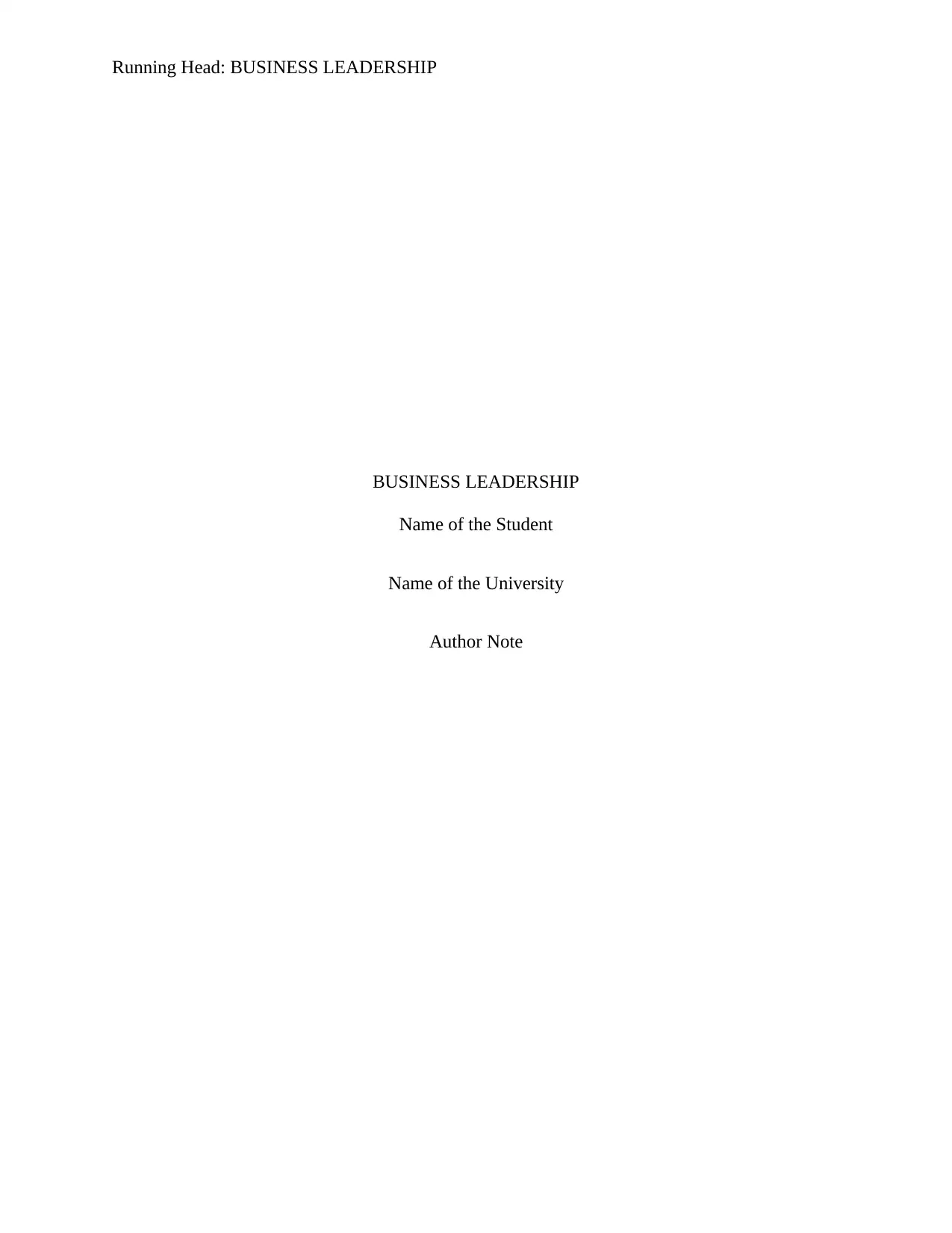
Running Head: BUSINESS LEADERSHIP
BUSINESS LEADERSHIP
Name of the Student
Name of the University
Author Note
BUSINESS LEADERSHIP
Name of the Student
Name of the University
Author Note
Secure Best Marks with AI Grader
Need help grading? Try our AI Grader for instant feedback on your assignments.
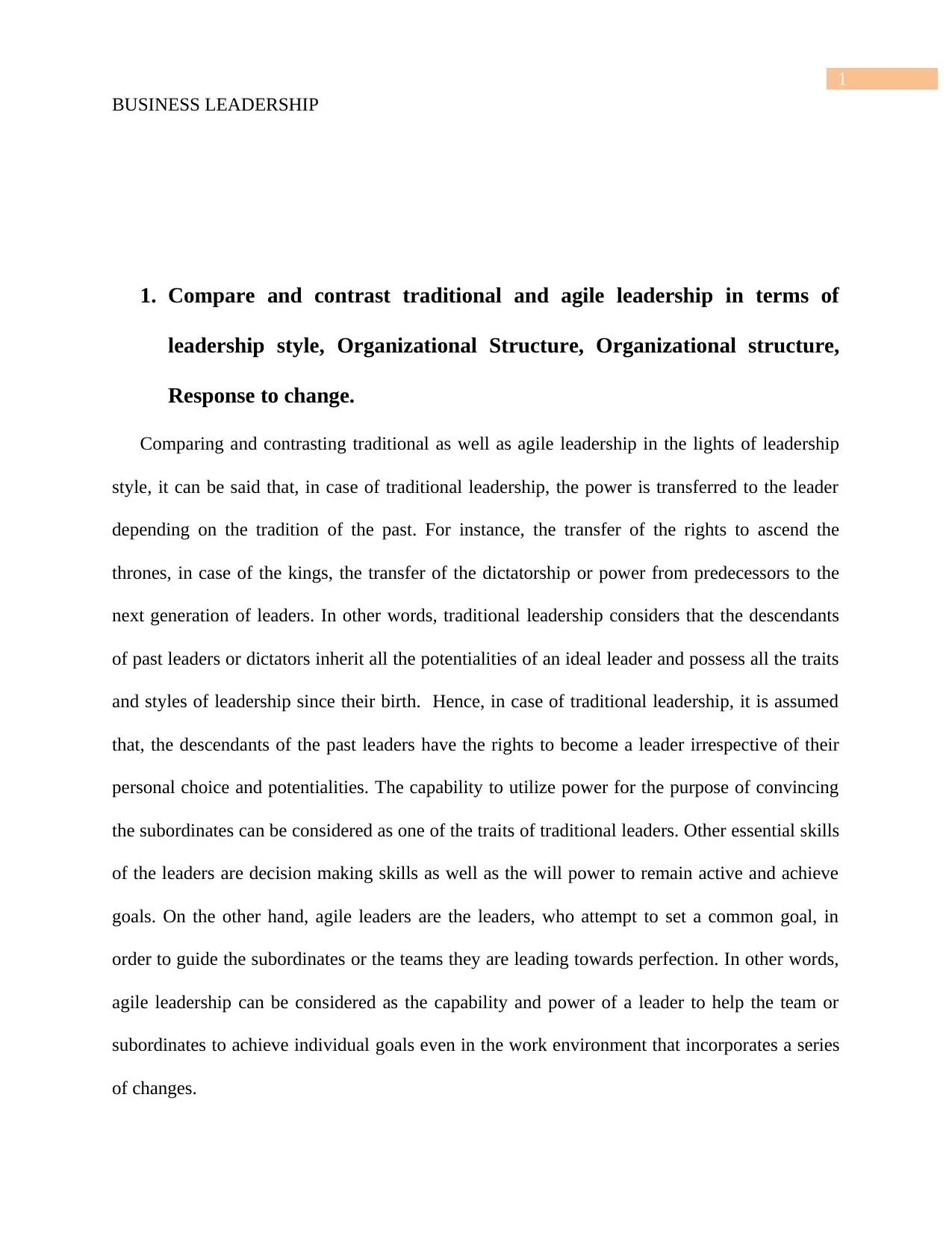
1
BUSINESS LEADERSHIP
1. Compare and contrast traditional and agile leadership in terms of
leadership style, Organizational Structure, Organizational structure,
Response to change.
Comparing and contrasting traditional as well as agile leadership in the lights of leadership
style, it can be said that, in case of traditional leadership, the power is transferred to the leader
depending on the tradition of the past. For instance, the transfer of the rights to ascend the
thrones, in case of the kings, the transfer of the dictatorship or power from predecessors to the
next generation of leaders. In other words, traditional leadership considers that the descendants
of past leaders or dictators inherit all the potentialities of an ideal leader and possess all the traits
and styles of leadership since their birth. Hence, in case of traditional leadership, it is assumed
that, the descendants of the past leaders have the rights to become a leader irrespective of their
personal choice and potentialities. The capability to utilize power for the purpose of convincing
the subordinates can be considered as one of the traits of traditional leaders. Other essential skills
of the leaders are decision making skills as well as the will power to remain active and achieve
goals. On the other hand, agile leaders are the leaders, who attempt to set a common goal, in
order to guide the subordinates or the teams they are leading towards perfection. In other words,
agile leadership can be considered as the capability and power of a leader to help the team or
subordinates to achieve individual goals even in the work environment that incorporates a series
of changes.
BUSINESS LEADERSHIP
1. Compare and contrast traditional and agile leadership in terms of
leadership style, Organizational Structure, Organizational structure,
Response to change.
Comparing and contrasting traditional as well as agile leadership in the lights of leadership
style, it can be said that, in case of traditional leadership, the power is transferred to the leader
depending on the tradition of the past. For instance, the transfer of the rights to ascend the
thrones, in case of the kings, the transfer of the dictatorship or power from predecessors to the
next generation of leaders. In other words, traditional leadership considers that the descendants
of past leaders or dictators inherit all the potentialities of an ideal leader and possess all the traits
and styles of leadership since their birth. Hence, in case of traditional leadership, it is assumed
that, the descendants of the past leaders have the rights to become a leader irrespective of their
personal choice and potentialities. The capability to utilize power for the purpose of convincing
the subordinates can be considered as one of the traits of traditional leaders. Other essential skills
of the leaders are decision making skills as well as the will power to remain active and achieve
goals. On the other hand, agile leaders are the leaders, who attempt to set a common goal, in
order to guide the subordinates or the teams they are leading towards perfection. In other words,
agile leadership can be considered as the capability and power of a leader to help the team or
subordinates to achieve individual goals even in the work environment that incorporates a series
of changes.
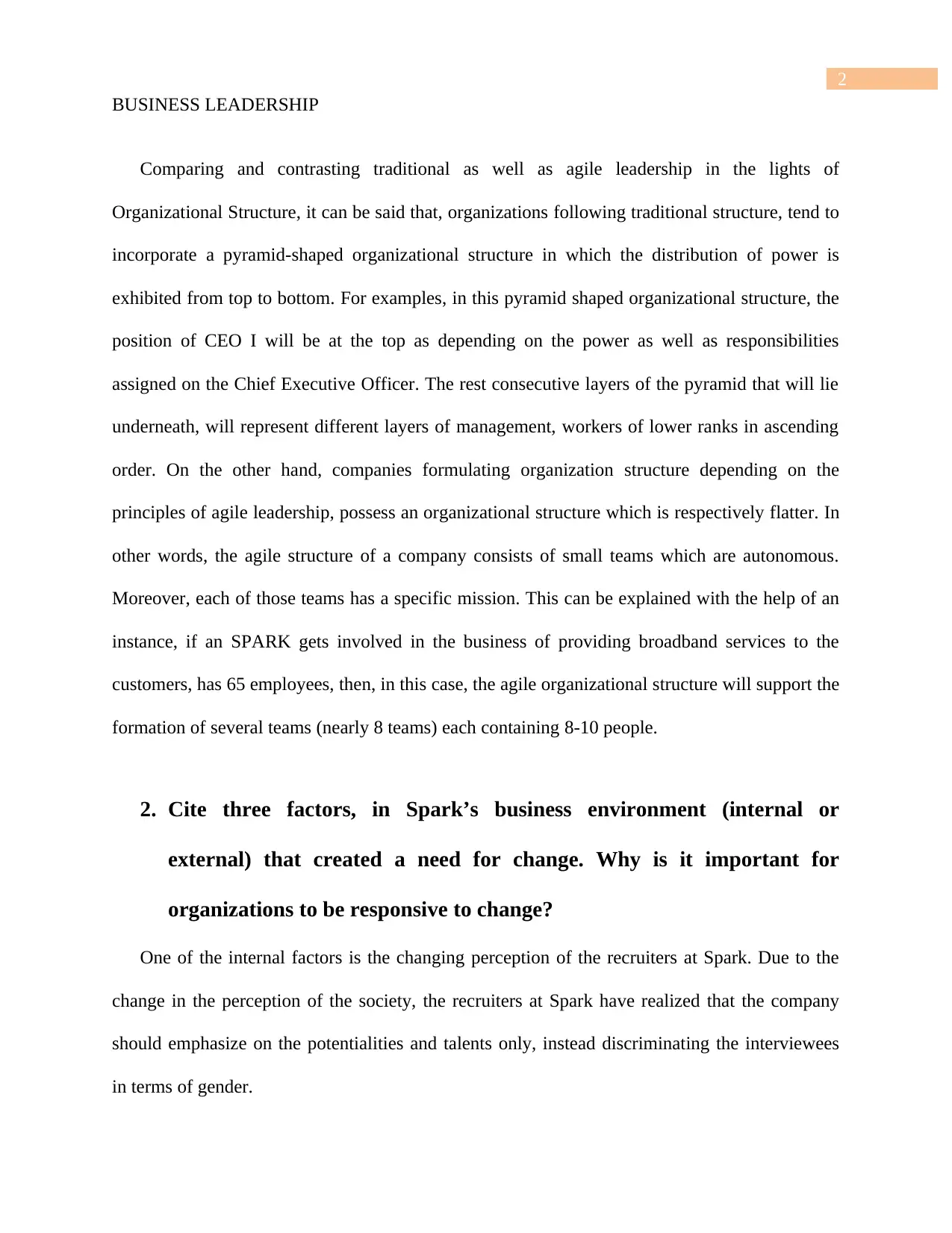
2
BUSINESS LEADERSHIP
Comparing and contrasting traditional as well as agile leadership in the lights of
Organizational Structure, it can be said that, organizations following traditional structure, tend to
incorporate a pyramid-shaped organizational structure in which the distribution of power is
exhibited from top to bottom. For examples, in this pyramid shaped organizational structure, the
position of CEO I will be at the top as depending on the power as well as responsibilities
assigned on the Chief Executive Officer. The rest consecutive layers of the pyramid that will lie
underneath, will represent different layers of management, workers of lower ranks in ascending
order. On the other hand, companies formulating organization structure depending on the
principles of agile leadership, possess an organizational structure which is respectively flatter. In
other words, the agile structure of a company consists of small teams which are autonomous.
Moreover, each of those teams has a specific mission. This can be explained with the help of an
instance, if an SPARK gets involved in the business of providing broadband services to the
customers, has 65 employees, then, in this case, the agile organizational structure will support the
formation of several teams (nearly 8 teams) each containing 8-10 people.
2. Cite three factors, in Spark’s business environment (internal or
external) that created a need for change. Why is it important for
organizations to be responsive to change?
One of the internal factors is the changing perception of the recruiters at Spark. Due to the
change in the perception of the society, the recruiters at Spark have realized that the company
should emphasize on the potentialities and talents only, instead discriminating the interviewees
in terms of gender.
BUSINESS LEADERSHIP
Comparing and contrasting traditional as well as agile leadership in the lights of
Organizational Structure, it can be said that, organizations following traditional structure, tend to
incorporate a pyramid-shaped organizational structure in which the distribution of power is
exhibited from top to bottom. For examples, in this pyramid shaped organizational structure, the
position of CEO I will be at the top as depending on the power as well as responsibilities
assigned on the Chief Executive Officer. The rest consecutive layers of the pyramid that will lie
underneath, will represent different layers of management, workers of lower ranks in ascending
order. On the other hand, companies formulating organization structure depending on the
principles of agile leadership, possess an organizational structure which is respectively flatter. In
other words, the agile structure of a company consists of small teams which are autonomous.
Moreover, each of those teams has a specific mission. This can be explained with the help of an
instance, if an SPARK gets involved in the business of providing broadband services to the
customers, has 65 employees, then, in this case, the agile organizational structure will support the
formation of several teams (nearly 8 teams) each containing 8-10 people.
2. Cite three factors, in Spark’s business environment (internal or
external) that created a need for change. Why is it important for
organizations to be responsive to change?
One of the internal factors is the changing perception of the recruiters at Spark. Due to the
change in the perception of the society, the recruiters at Spark have realized that the company
should emphasize on the potentialities and talents only, instead discriminating the interviewees
in terms of gender.
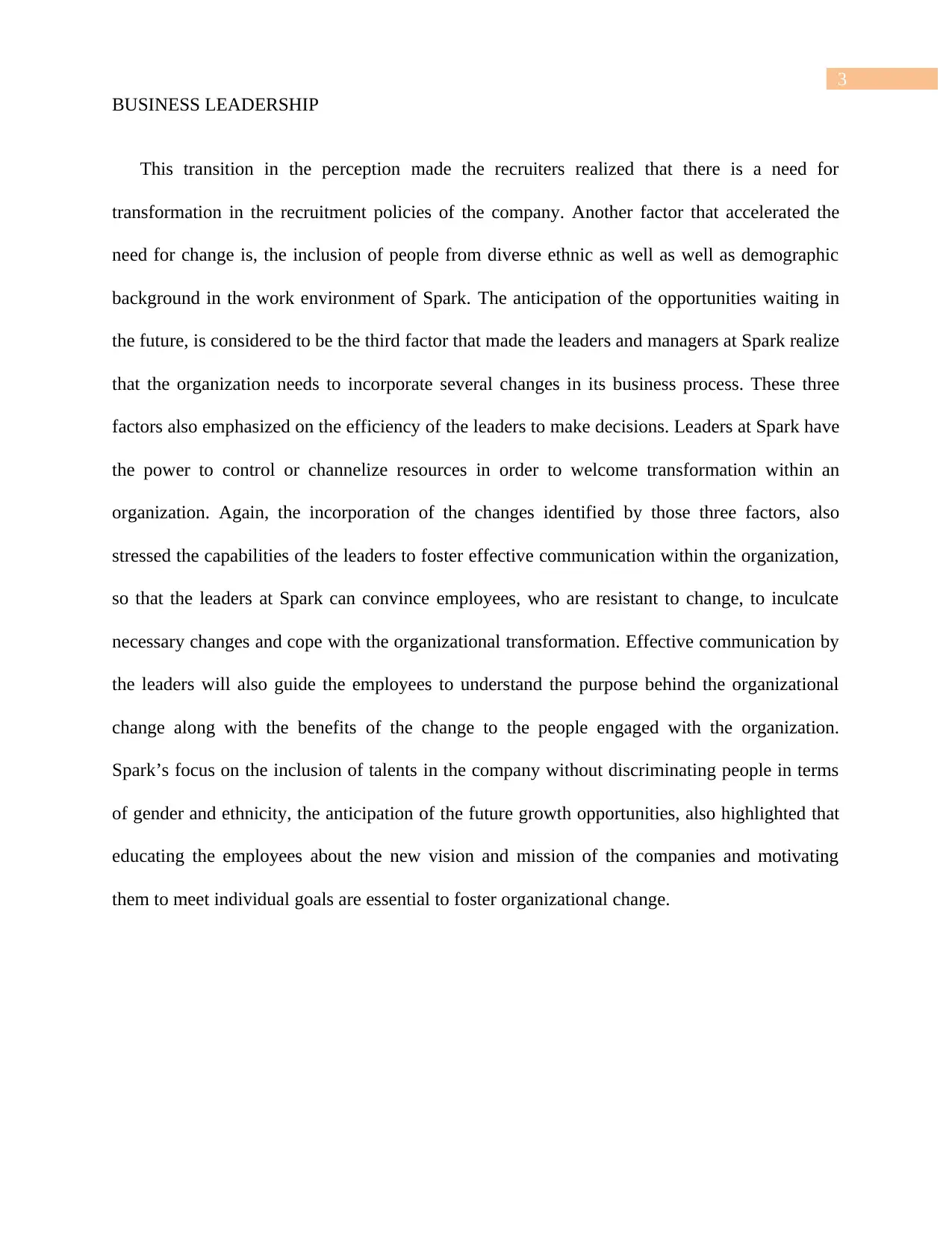
3
BUSINESS LEADERSHIP
This transition in the perception made the recruiters realized that there is a need for
transformation in the recruitment policies of the company. Another factor that accelerated the
need for change is, the inclusion of people from diverse ethnic as well as well as demographic
background in the work environment of Spark. The anticipation of the opportunities waiting in
the future, is considered to be the third factor that made the leaders and managers at Spark realize
that the organization needs to incorporate several changes in its business process. These three
factors also emphasized on the efficiency of the leaders to make decisions. Leaders at Spark have
the power to control or channelize resources in order to welcome transformation within an
organization. Again, the incorporation of the changes identified by those three factors, also
stressed the capabilities of the leaders to foster effective communication within the organization,
so that the leaders at Spark can convince employees, who are resistant to change, to inculcate
necessary changes and cope with the organizational transformation. Effective communication by
the leaders will also guide the employees to understand the purpose behind the organizational
change along with the benefits of the change to the people engaged with the organization.
Spark’s focus on the inclusion of talents in the company without discriminating people in terms
of gender and ethnicity, the anticipation of the future growth opportunities, also highlighted that
educating the employees about the new vision and mission of the companies and motivating
them to meet individual goals are essential to foster organizational change.
BUSINESS LEADERSHIP
This transition in the perception made the recruiters realized that there is a need for
transformation in the recruitment policies of the company. Another factor that accelerated the
need for change is, the inclusion of people from diverse ethnic as well as well as demographic
background in the work environment of Spark. The anticipation of the opportunities waiting in
the future, is considered to be the third factor that made the leaders and managers at Spark realize
that the organization needs to incorporate several changes in its business process. These three
factors also emphasized on the efficiency of the leaders to make decisions. Leaders at Spark have
the power to control or channelize resources in order to welcome transformation within an
organization. Again, the incorporation of the changes identified by those three factors, also
stressed the capabilities of the leaders to foster effective communication within the organization,
so that the leaders at Spark can convince employees, who are resistant to change, to inculcate
necessary changes and cope with the organizational transformation. Effective communication by
the leaders will also guide the employees to understand the purpose behind the organizational
change along with the benefits of the change to the people engaged with the organization.
Spark’s focus on the inclusion of talents in the company without discriminating people in terms
of gender and ethnicity, the anticipation of the future growth opportunities, also highlighted that
educating the employees about the new vision and mission of the companies and motivating
them to meet individual goals are essential to foster organizational change.
Secure Best Marks with AI Grader
Need help grading? Try our AI Grader for instant feedback on your assignments.
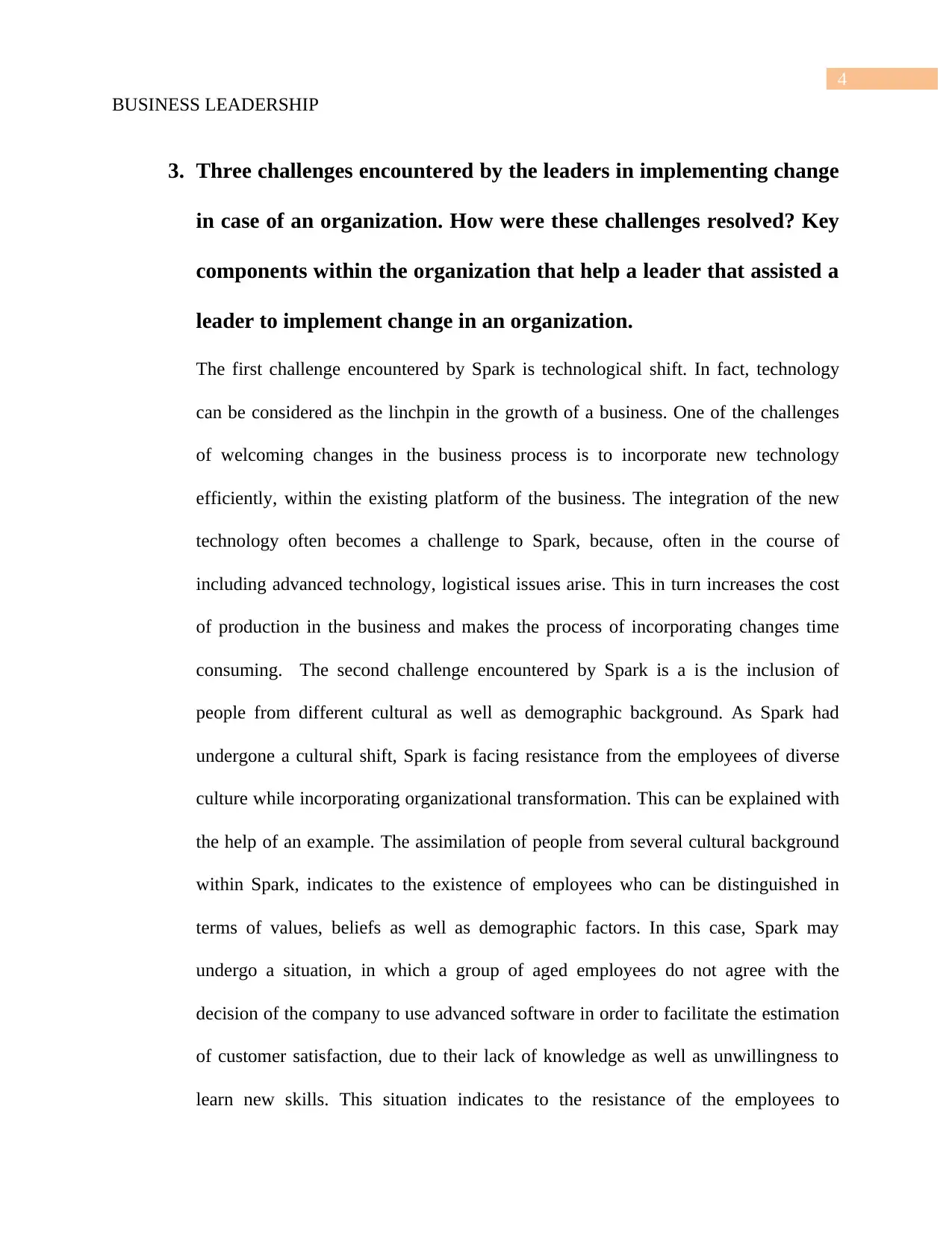
4
BUSINESS LEADERSHIP
3. Three challenges encountered by the leaders in implementing change
in case of an organization. How were these challenges resolved? Key
components within the organization that help a leader that assisted a
leader to implement change in an organization.
The first challenge encountered by Spark is technological shift. In fact, technology
can be considered as the linchpin in the growth of a business. One of the challenges
of welcoming changes in the business process is to incorporate new technology
efficiently, within the existing platform of the business. The integration of the new
technology often becomes a challenge to Spark, because, often in the course of
including advanced technology, logistical issues arise. This in turn increases the cost
of production in the business and makes the process of incorporating changes time
consuming. The second challenge encountered by Spark is a is the inclusion of
people from different cultural as well as demographic background. As Spark had
undergone a cultural shift, Spark is facing resistance from the employees of diverse
culture while incorporating organizational transformation. This can be explained with
the help of an example. The assimilation of people from several cultural background
within Spark, indicates to the existence of employees who can be distinguished in
terms of values, beliefs as well as demographic factors. In this case, Spark may
undergo a situation, in which a group of aged employees do not agree with the
decision of the company to use advanced software in order to facilitate the estimation
of customer satisfaction, due to their lack of knowledge as well as unwillingness to
learn new skills. This situation indicates to the resistance of the employees to
BUSINESS LEADERSHIP
3. Three challenges encountered by the leaders in implementing change
in case of an organization. How were these challenges resolved? Key
components within the organization that help a leader that assisted a
leader to implement change in an organization.
The first challenge encountered by Spark is technological shift. In fact, technology
can be considered as the linchpin in the growth of a business. One of the challenges
of welcoming changes in the business process is to incorporate new technology
efficiently, within the existing platform of the business. The integration of the new
technology often becomes a challenge to Spark, because, often in the course of
including advanced technology, logistical issues arise. This in turn increases the cost
of production in the business and makes the process of incorporating changes time
consuming. The second challenge encountered by Spark is a is the inclusion of
people from different cultural as well as demographic background. As Spark had
undergone a cultural shift, Spark is facing resistance from the employees of diverse
culture while incorporating organizational transformation. This can be explained with
the help of an example. The assimilation of people from several cultural background
within Spark, indicates to the existence of employees who can be distinguished in
terms of values, beliefs as well as demographic factors. In this case, Spark may
undergo a situation, in which a group of aged employees do not agree with the
decision of the company to use advanced software in order to facilitate the estimation
of customer satisfaction, due to their lack of knowledge as well as unwillingness to
learn new skills. This situation indicates to the resistance of the employees to
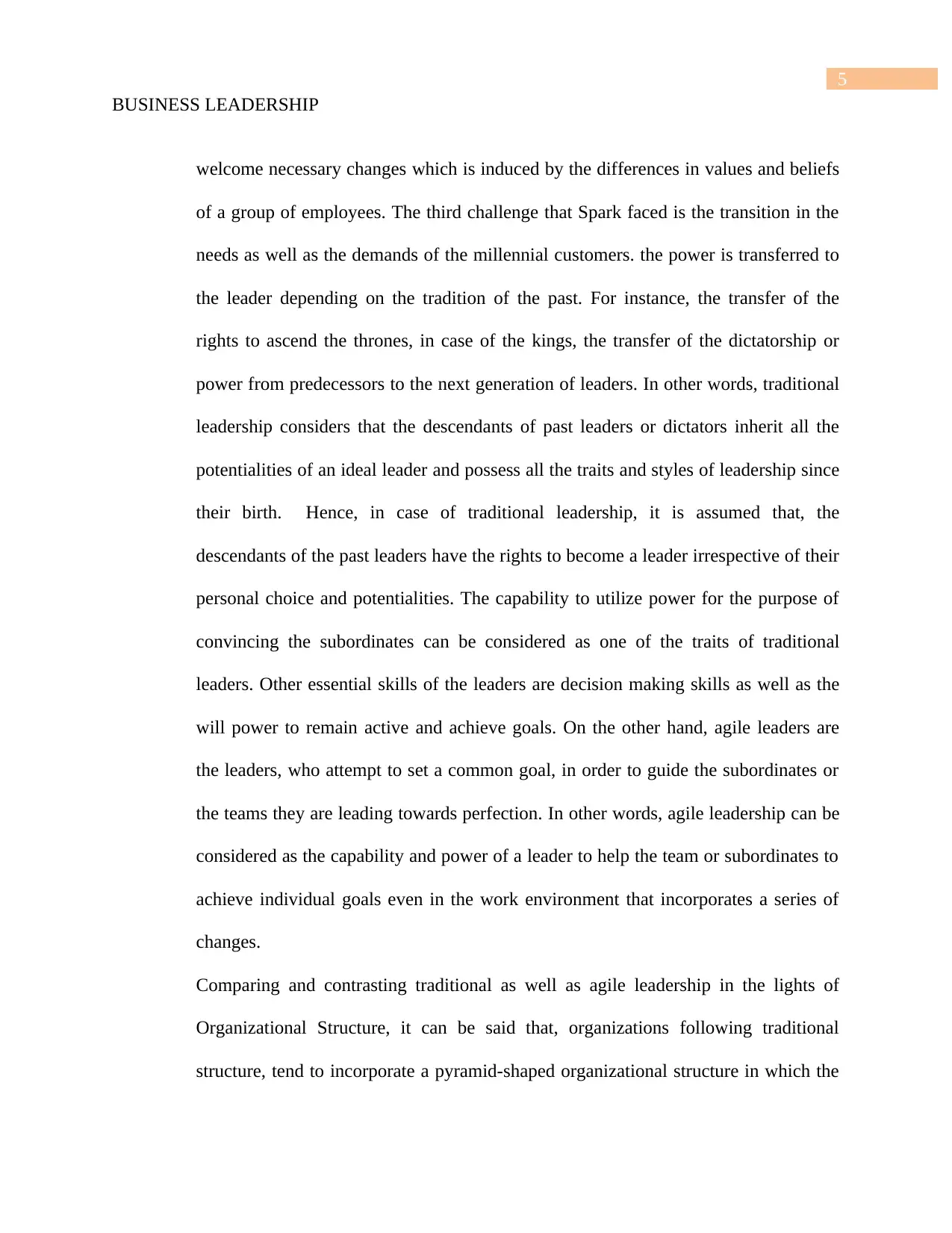
5
BUSINESS LEADERSHIP
welcome necessary changes which is induced by the differences in values and beliefs
of a group of employees. The third challenge that Spark faced is the transition in the
needs as well as the demands of the millennial customers. the power is transferred to
the leader depending on the tradition of the past. For instance, the transfer of the
rights to ascend the thrones, in case of the kings, the transfer of the dictatorship or
power from predecessors to the next generation of leaders. In other words, traditional
leadership considers that the descendants of past leaders or dictators inherit all the
potentialities of an ideal leader and possess all the traits and styles of leadership since
their birth. Hence, in case of traditional leadership, it is assumed that, the
descendants of the past leaders have the rights to become a leader irrespective of their
personal choice and potentialities. The capability to utilize power for the purpose of
convincing the subordinates can be considered as one of the traits of traditional
leaders. Other essential skills of the leaders are decision making skills as well as the
will power to remain active and achieve goals. On the other hand, agile leaders are
the leaders, who attempt to set a common goal, in order to guide the subordinates or
the teams they are leading towards perfection. In other words, agile leadership can be
considered as the capability and power of a leader to help the team or subordinates to
achieve individual goals even in the work environment that incorporates a series of
changes.
Comparing and contrasting traditional as well as agile leadership in the lights of
Organizational Structure, it can be said that, organizations following traditional
structure, tend to incorporate a pyramid-shaped organizational structure in which the
BUSINESS LEADERSHIP
welcome necessary changes which is induced by the differences in values and beliefs
of a group of employees. The third challenge that Spark faced is the transition in the
needs as well as the demands of the millennial customers. the power is transferred to
the leader depending on the tradition of the past. For instance, the transfer of the
rights to ascend the thrones, in case of the kings, the transfer of the dictatorship or
power from predecessors to the next generation of leaders. In other words, traditional
leadership considers that the descendants of past leaders or dictators inherit all the
potentialities of an ideal leader and possess all the traits and styles of leadership since
their birth. Hence, in case of traditional leadership, it is assumed that, the
descendants of the past leaders have the rights to become a leader irrespective of their
personal choice and potentialities. The capability to utilize power for the purpose of
convincing the subordinates can be considered as one of the traits of traditional
leaders. Other essential skills of the leaders are decision making skills as well as the
will power to remain active and achieve goals. On the other hand, agile leaders are
the leaders, who attempt to set a common goal, in order to guide the subordinates or
the teams they are leading towards perfection. In other words, agile leadership can be
considered as the capability and power of a leader to help the team or subordinates to
achieve individual goals even in the work environment that incorporates a series of
changes.
Comparing and contrasting traditional as well as agile leadership in the lights of
Organizational Structure, it can be said that, organizations following traditional
structure, tend to incorporate a pyramid-shaped organizational structure in which the
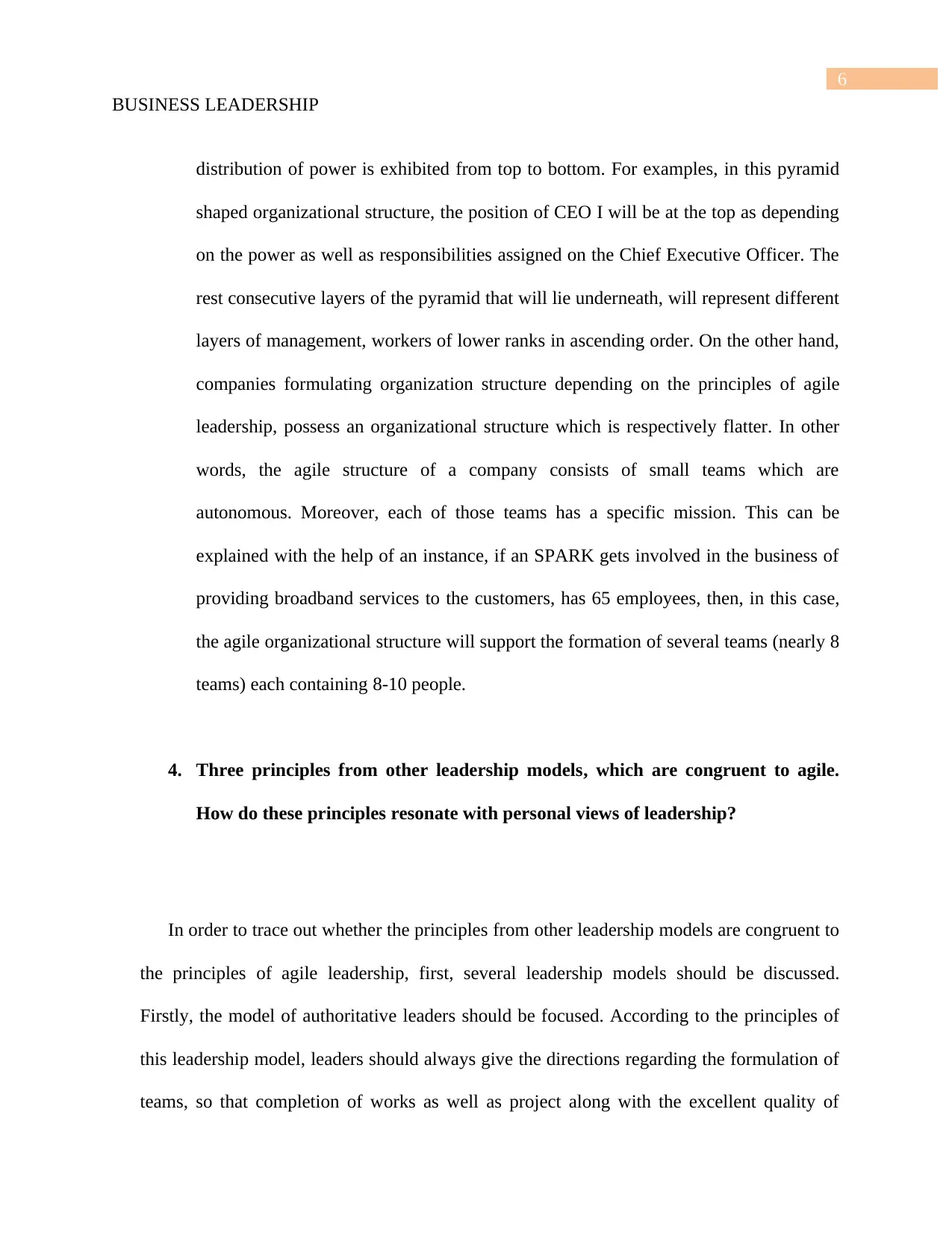
6
BUSINESS LEADERSHIP
distribution of power is exhibited from top to bottom. For examples, in this pyramid
shaped organizational structure, the position of CEO I will be at the top as depending
on the power as well as responsibilities assigned on the Chief Executive Officer. The
rest consecutive layers of the pyramid that will lie underneath, will represent different
layers of management, workers of lower ranks in ascending order. On the other hand,
companies formulating organization structure depending on the principles of agile
leadership, possess an organizational structure which is respectively flatter. In other
words, the agile structure of a company consists of small teams which are
autonomous. Moreover, each of those teams has a specific mission. This can be
explained with the help of an instance, if an SPARK gets involved in the business of
providing broadband services to the customers, has 65 employees, then, in this case,
the agile organizational structure will support the formation of several teams (nearly 8
teams) each containing 8-10 people.
4. Three principles from other leadership models, which are congruent to agile.
How do these principles resonate with personal views of leadership?
In order to trace out whether the principles from other leadership models are congruent to
the principles of agile leadership, first, several leadership models should be discussed.
Firstly, the model of authoritative leaders should be focused. According to the principles of
this leadership model, leaders should always give the directions regarding the formulation of
teams, so that completion of works as well as project along with the excellent quality of
BUSINESS LEADERSHIP
distribution of power is exhibited from top to bottom. For examples, in this pyramid
shaped organizational structure, the position of CEO I will be at the top as depending
on the power as well as responsibilities assigned on the Chief Executive Officer. The
rest consecutive layers of the pyramid that will lie underneath, will represent different
layers of management, workers of lower ranks in ascending order. On the other hand,
companies formulating organization structure depending on the principles of agile
leadership, possess an organizational structure which is respectively flatter. In other
words, the agile structure of a company consists of small teams which are
autonomous. Moreover, each of those teams has a specific mission. This can be
explained with the help of an instance, if an SPARK gets involved in the business of
providing broadband services to the customers, has 65 employees, then, in this case,
the agile organizational structure will support the formation of several teams (nearly 8
teams) each containing 8-10 people.
4. Three principles from other leadership models, which are congruent to agile.
How do these principles resonate with personal views of leadership?
In order to trace out whether the principles from other leadership models are congruent to
the principles of agile leadership, first, several leadership models should be discussed.
Firstly, the model of authoritative leaders should be focused. According to the principles of
this leadership model, leaders should always give the directions regarding the formulation of
teams, so that completion of works as well as project along with the excellent quality of
Paraphrase This Document
Need a fresh take? Get an instant paraphrase of this document with our AI Paraphraser
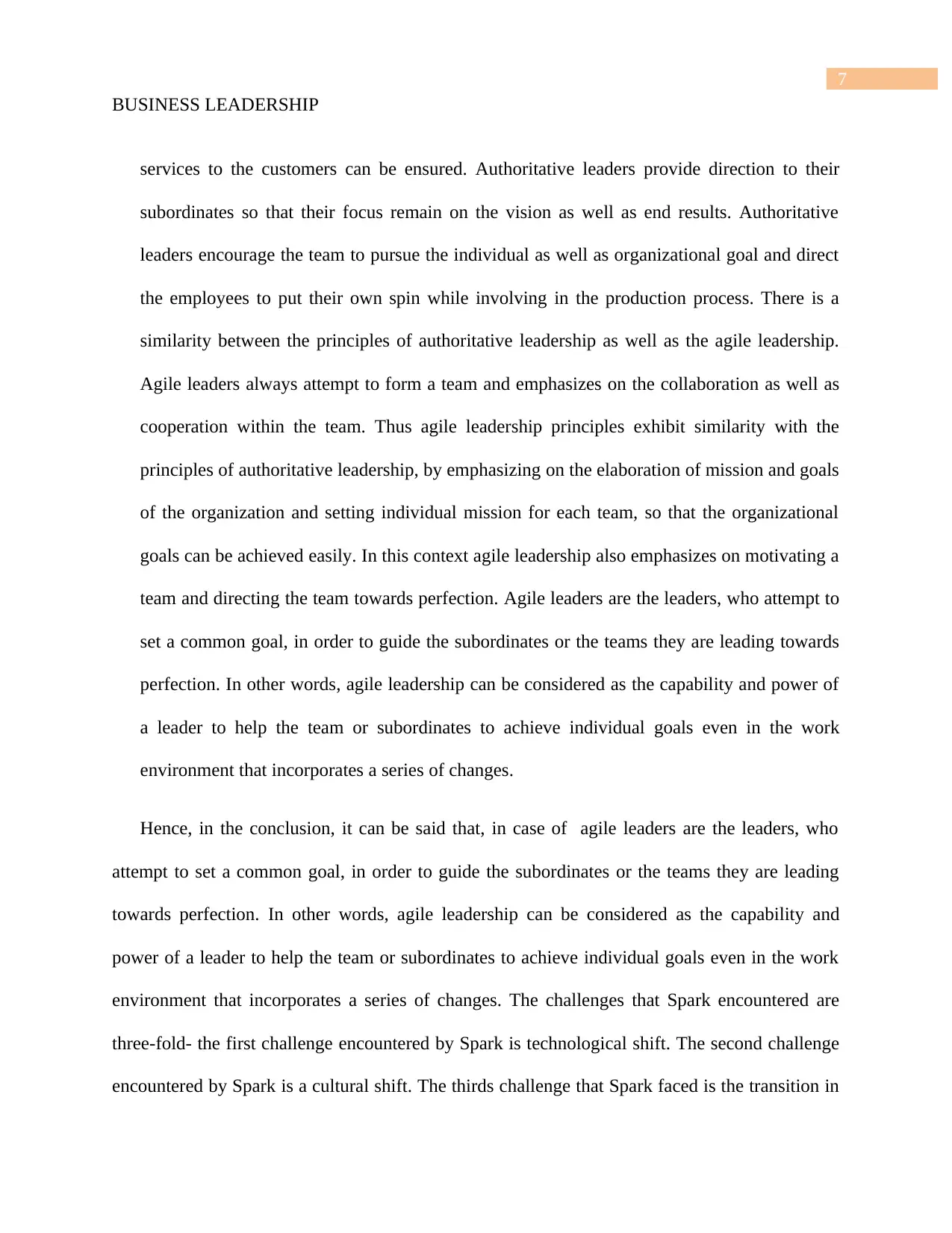
7
BUSINESS LEADERSHIP
services to the customers can be ensured. Authoritative leaders provide direction to their
subordinates so that their focus remain on the vision as well as end results. Authoritative
leaders encourage the team to pursue the individual as well as organizational goal and direct
the employees to put their own spin while involving in the production process. There is a
similarity between the principles of authoritative leadership as well as the agile leadership.
Agile leaders always attempt to form a team and emphasizes on the collaboration as well as
cooperation within the team. Thus agile leadership principles exhibit similarity with the
principles of authoritative leadership, by emphasizing on the elaboration of mission and goals
of the organization and setting individual mission for each team, so that the organizational
goals can be achieved easily. In this context agile leadership also emphasizes on motivating a
team and directing the team towards perfection. Agile leaders are the leaders, who attempt to
set a common goal, in order to guide the subordinates or the teams they are leading towards
perfection. In other words, agile leadership can be considered as the capability and power of
a leader to help the team or subordinates to achieve individual goals even in the work
environment that incorporates a series of changes.
Hence, in the conclusion, it can be said that, in case of agile leaders are the leaders, who
attempt to set a common goal, in order to guide the subordinates or the teams they are leading
towards perfection. In other words, agile leadership can be considered as the capability and
power of a leader to help the team or subordinates to achieve individual goals even in the work
environment that incorporates a series of changes. The challenges that Spark encountered are
three-fold- the first challenge encountered by Spark is technological shift. The second challenge
encountered by Spark is a cultural shift. The thirds challenge that Spark faced is the transition in
BUSINESS LEADERSHIP
services to the customers can be ensured. Authoritative leaders provide direction to their
subordinates so that their focus remain on the vision as well as end results. Authoritative
leaders encourage the team to pursue the individual as well as organizational goal and direct
the employees to put their own spin while involving in the production process. There is a
similarity between the principles of authoritative leadership as well as the agile leadership.
Agile leaders always attempt to form a team and emphasizes on the collaboration as well as
cooperation within the team. Thus agile leadership principles exhibit similarity with the
principles of authoritative leadership, by emphasizing on the elaboration of mission and goals
of the organization and setting individual mission for each team, so that the organizational
goals can be achieved easily. In this context agile leadership also emphasizes on motivating a
team and directing the team towards perfection. Agile leaders are the leaders, who attempt to
set a common goal, in order to guide the subordinates or the teams they are leading towards
perfection. In other words, agile leadership can be considered as the capability and power of
a leader to help the team or subordinates to achieve individual goals even in the work
environment that incorporates a series of changes.
Hence, in the conclusion, it can be said that, in case of agile leaders are the leaders, who
attempt to set a common goal, in order to guide the subordinates or the teams they are leading
towards perfection. In other words, agile leadership can be considered as the capability and
power of a leader to help the team or subordinates to achieve individual goals even in the work
environment that incorporates a series of changes. The challenges that Spark encountered are
three-fold- the first challenge encountered by Spark is technological shift. The second challenge
encountered by Spark is a cultural shift. The thirds challenge that Spark faced is the transition in
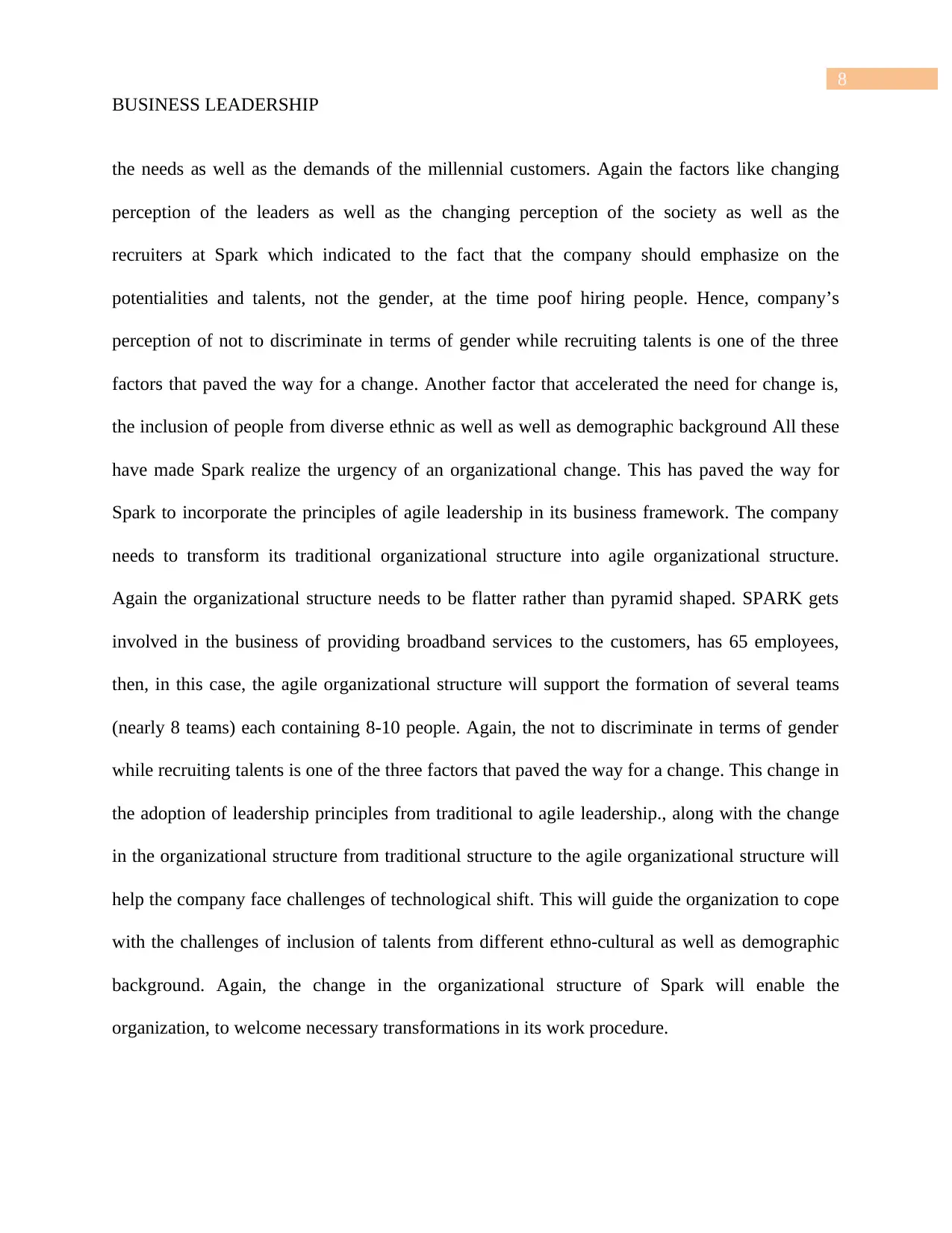
8
BUSINESS LEADERSHIP
the needs as well as the demands of the millennial customers. Again the factors like changing
perception of the leaders as well as the changing perception of the society as well as the
recruiters at Spark which indicated to the fact that the company should emphasize on the
potentialities and talents, not the gender, at the time poof hiring people. Hence, company’s
perception of not to discriminate in terms of gender while recruiting talents is one of the three
factors that paved the way for a change. Another factor that accelerated the need for change is,
the inclusion of people from diverse ethnic as well as well as demographic background All these
have made Spark realize the urgency of an organizational change. This has paved the way for
Spark to incorporate the principles of agile leadership in its business framework. The company
needs to transform its traditional organizational structure into agile organizational structure.
Again the organizational structure needs to be flatter rather than pyramid shaped. SPARK gets
involved in the business of providing broadband services to the customers, has 65 employees,
then, in this case, the agile organizational structure will support the formation of several teams
(nearly 8 teams) each containing 8-10 people. Again, the not to discriminate in terms of gender
while recruiting talents is one of the three factors that paved the way for a change. This change in
the adoption of leadership principles from traditional to agile leadership., along with the change
in the organizational structure from traditional structure to the agile organizational structure will
help the company face challenges of technological shift. This will guide the organization to cope
with the challenges of inclusion of talents from different ethno-cultural as well as demographic
background. Again, the change in the organizational structure of Spark will enable the
organization, to welcome necessary transformations in its work procedure.
BUSINESS LEADERSHIP
the needs as well as the demands of the millennial customers. Again the factors like changing
perception of the leaders as well as the changing perception of the society as well as the
recruiters at Spark which indicated to the fact that the company should emphasize on the
potentialities and talents, not the gender, at the time poof hiring people. Hence, company’s
perception of not to discriminate in terms of gender while recruiting talents is one of the three
factors that paved the way for a change. Another factor that accelerated the need for change is,
the inclusion of people from diverse ethnic as well as well as demographic background All these
have made Spark realize the urgency of an organizational change. This has paved the way for
Spark to incorporate the principles of agile leadership in its business framework. The company
needs to transform its traditional organizational structure into agile organizational structure.
Again the organizational structure needs to be flatter rather than pyramid shaped. SPARK gets
involved in the business of providing broadband services to the customers, has 65 employees,
then, in this case, the agile organizational structure will support the formation of several teams
(nearly 8 teams) each containing 8-10 people. Again, the not to discriminate in terms of gender
while recruiting talents is one of the three factors that paved the way for a change. This change in
the adoption of leadership principles from traditional to agile leadership., along with the change
in the organizational structure from traditional structure to the agile organizational structure will
help the company face challenges of technological shift. This will guide the organization to cope
with the challenges of inclusion of talents from different ethno-cultural as well as demographic
background. Again, the change in the organizational structure of Spark will enable the
organization, to welcome necessary transformations in its work procedure.

9
BUSINESS LEADERSHIP
BUSINESS LEADERSHIP
Secure Best Marks with AI Grader
Need help grading? Try our AI Grader for instant feedback on your assignments.
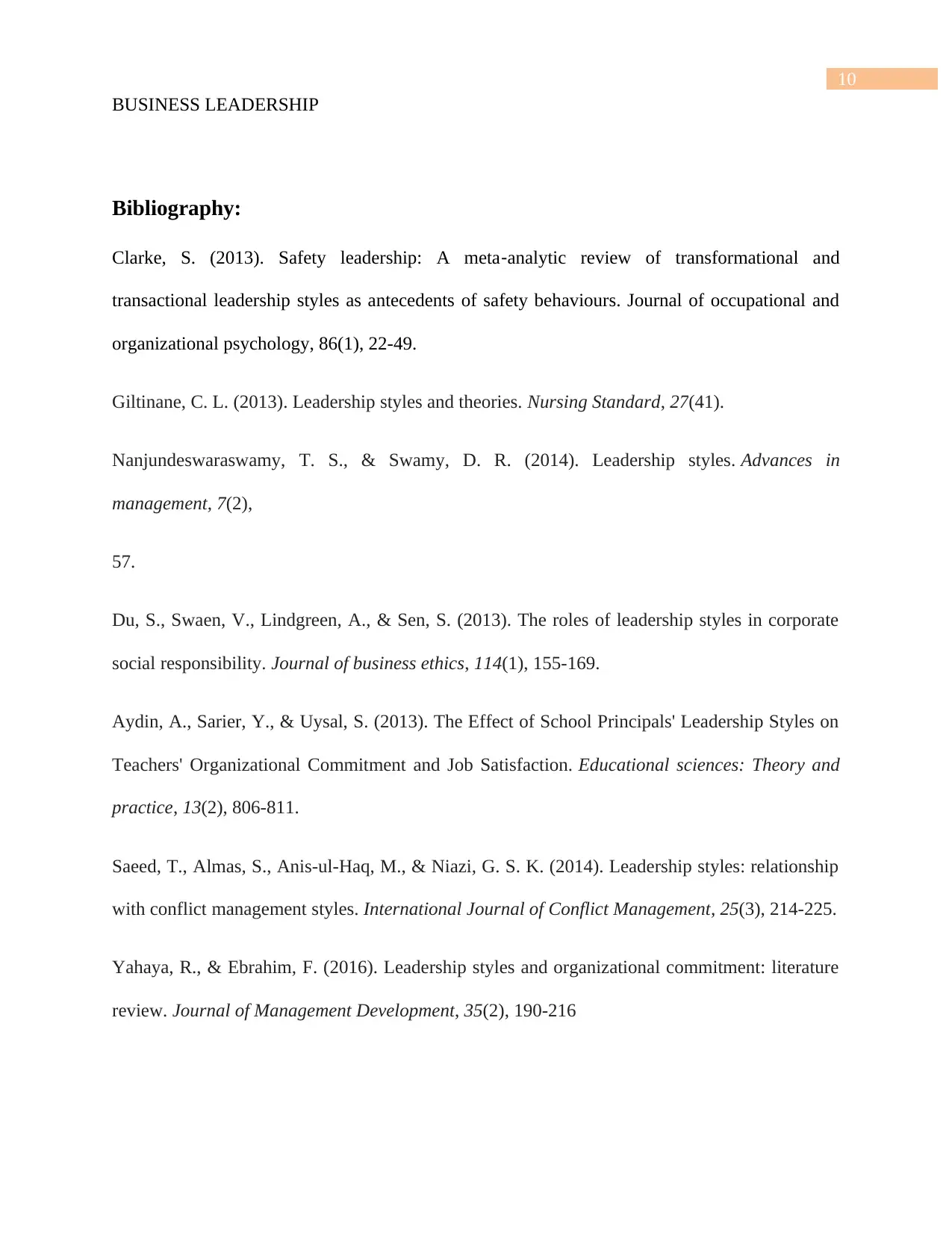
10
BUSINESS LEADERSHIP
Bibliography:
Clarke, S. (2013). Safety leadership: A meta‐analytic review of transformational and
transactional leadership styles as antecedents of safety behaviours. Journal of occupational and
organizational psychology, 86(1), 22-49.
Giltinane, C. L. (2013). Leadership styles and theories. Nursing Standard, 27(41).
Nanjundeswaraswamy, T. S., & Swamy, D. R. (2014). Leadership styles. Advances in
management, 7(2),
57.
Du, S., Swaen, V., Lindgreen, A., & Sen, S. (2013). The roles of leadership styles in corporate
social responsibility. Journal of business ethics, 114(1), 155-169.
Aydin, A., Sarier, Y., & Uysal, S. (2013). The Effect of School Principals' Leadership Styles on
Teachers' Organizational Commitment and Job Satisfaction. Educational sciences: Theory and
practice, 13(2), 806-811.
Saeed, T., Almas, S., Anis-ul-Haq, M., & Niazi, G. S. K. (2014). Leadership styles: relationship
with conflict management styles. International Journal of Conflict Management, 25(3), 214-225.
Yahaya, R., & Ebrahim, F. (2016). Leadership styles and organizational commitment: literature
review. Journal of Management Development, 35(2), 190-216
BUSINESS LEADERSHIP
Bibliography:
Clarke, S. (2013). Safety leadership: A meta‐analytic review of transformational and
transactional leadership styles as antecedents of safety behaviours. Journal of occupational and
organizational psychology, 86(1), 22-49.
Giltinane, C. L. (2013). Leadership styles and theories. Nursing Standard, 27(41).
Nanjundeswaraswamy, T. S., & Swamy, D. R. (2014). Leadership styles. Advances in
management, 7(2),
57.
Du, S., Swaen, V., Lindgreen, A., & Sen, S. (2013). The roles of leadership styles in corporate
social responsibility. Journal of business ethics, 114(1), 155-169.
Aydin, A., Sarier, Y., & Uysal, S. (2013). The Effect of School Principals' Leadership Styles on
Teachers' Organizational Commitment and Job Satisfaction. Educational sciences: Theory and
practice, 13(2), 806-811.
Saeed, T., Almas, S., Anis-ul-Haq, M., & Niazi, G. S. K. (2014). Leadership styles: relationship
with conflict management styles. International Journal of Conflict Management, 25(3), 214-225.
Yahaya, R., & Ebrahim, F. (2016). Leadership styles and organizational commitment: literature
review. Journal of Management Development, 35(2), 190-216
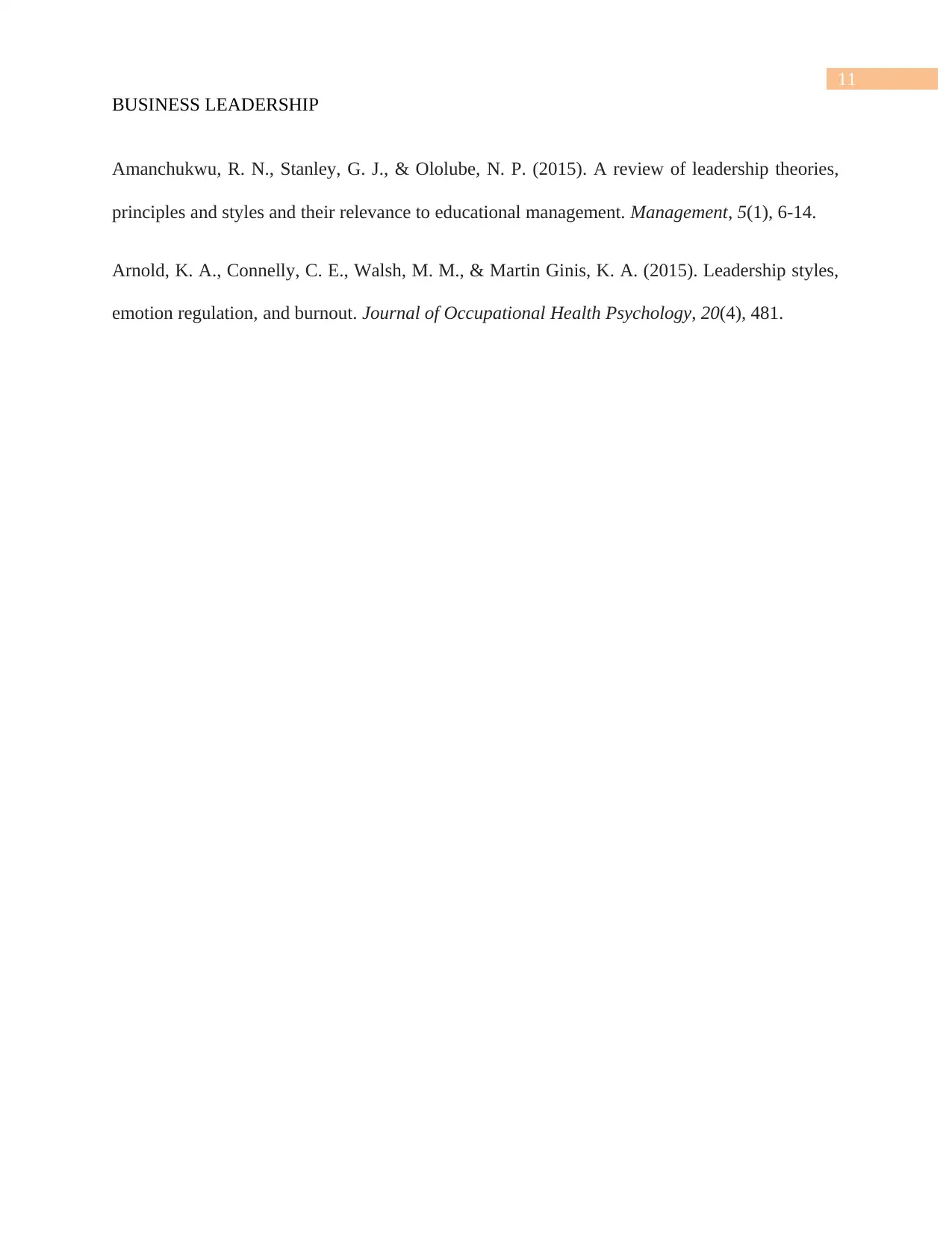
11
BUSINESS LEADERSHIP
Amanchukwu, R. N., Stanley, G. J., & Ololube, N. P. (2015). A review of leadership theories,
principles and styles and their relevance to educational management. Management, 5(1), 6-14.
Arnold, K. A., Connelly, C. E., Walsh, M. M., & Martin Ginis, K. A. (2015). Leadership styles,
emotion regulation, and burnout. Journal of Occupational Health Psychology, 20(4), 481.
BUSINESS LEADERSHIP
Amanchukwu, R. N., Stanley, G. J., & Ololube, N. P. (2015). A review of leadership theories,
principles and styles and their relevance to educational management. Management, 5(1), 6-14.
Arnold, K. A., Connelly, C. E., Walsh, M. M., & Martin Ginis, K. A. (2015). Leadership styles,
emotion regulation, and burnout. Journal of Occupational Health Psychology, 20(4), 481.
1 out of 12
Related Documents
Your All-in-One AI-Powered Toolkit for Academic Success.
+13062052269
info@desklib.com
Available 24*7 on WhatsApp / Email
![[object Object]](/_next/static/media/star-bottom.7253800d.svg)
Unlock your academic potential
© 2024 | Zucol Services PVT LTD | All rights reserved.





